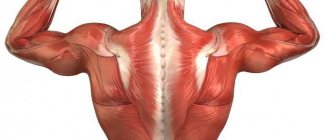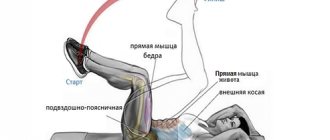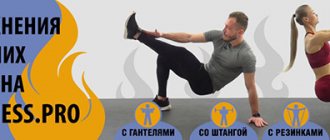Antagonist muscles are muscle groups whose actions are anatomically opposite to each other. For example, the muscles located in the chest area are pressers, the muscles located in the back are responsible for traction.
These processes occur during one anatomical action; the only difference is that with the same force vector, the position of the torso changes.
Based on their functional characteristics, muscle groups are divided into several main types:
- flexor muscles
- extensor muscles
- synergistic muscles
- antagonist muscles.
Synergists are muscles that produce movements in different directions at the same time.
Antagonist muscles perform opposite functions. For example, in order to bend your back, several are involved at the same time, and they all belong to the category of synergists.
The muscles that are responsible for extension of the torso are antagonists.
Almost all antagonistic muscles interact with one or two joints, so when they contract, the joints begin to move.
The most common types of antagonist muscle movements include flexion, extension, rotation, etc. The muscles responsible for flexion are located in front of the joints.
Behind the joints are antagonists, which are necessary for extension of the torso and limbs. However, in the knee and ankle joints this scheme is used exactly the opposite.
Synergistic muscles: examples and description
All physical actions that a person performs are performed thanks to muscles.
All of them are divided into several groups and are called synergists, agonists, antagonists, pronators, supinators. Muscles move in all joints, hold the body in an upright position, and provide movement of the arms and legs. Which muscles are synergistic, and which are agonists and antagonists, can be understood if we remember what functions they perform and where they are located.
The second group is voluntary muscles. It consists of over 600 muscles, and they can contract at the will of consciousness. These include the superficial muscles of the human body (except the cardiac muscle).
Muscles of the human body
The entire human body can be divided into several groups. These are the muscles of the trunk, head, upper and lower extremities. They can voluntarily contract to perform any action.
The body can be divided into muscles:
- necks - participate in head movement;
- chest – pectoralis major and minor, intercostal muscles;
- abdomen – straight, external and internal oblique;
- back – trapezoidal, broadest.
It is worth noting another muscle of the body - the diaphragm. It divides the chest and abdominal cavities and is involved in breathing.
The muscles of the upper limb are the biceps and triceps.
Muscles of the lower limb - quadriceps, biceps femoris.
The listed muscles are not all, but only the largest. With their help, you can understand the mechanism of action of agonists and antagonists.
Functions
According to the functions performed, all muscles perform the following types of movements: flexion, extension, abduction, adduction, pronation, supination.
Each action is ensured by the work of several muscle fibers. They can interact with each other and perform certain work in a coordinated manner.
Almost all muscles are attached to one or more joints. Thanks to this property, their movement is ensured.
Typically, the flexors are located in the front (biceps, rectus abdominis, delta), extensors in the back (triceps, back extensors, gluteal muscles). The exception is the knee and ankle joints. Here the muscles are located in reverse, quadriceps in front, hamstrings in back.
The muscles that provide the abduction movement are located outside the joint (medium deltoids, gluteus medius), and the adduction muscles are located inside (the hip adductors).
Rotation is carried out by muscles located diagonally or transversely from the vertical axis.
Interaction
No physical exercise or action is performed in isolation by one muscle. Several muscle fibers are always involved in the work.
Depending on the type of interaction, several groups are distinguished: synergistic muscles, agonists, antagonists. Rotation is provided by pronators (inward rotation) and supinators (outward rotation).
If several muscles are involved in a movement and they perform an action together (for example, flexion), then they are called agonist muscles.
Muscles involved in the opposite action are called antagonists.
Synergistic muscles are individual muscles that perform a joint action with others in one specific movement.
Let's look at an example. Synergistic muscles are involved in traction. Some of them work together and pull in one direction, while others make a different movement, stabilizing the pull in the opposite direction.
To understand which muscles are agonists and which are antagonists, you need to remember their main groups.
Muscle work (elements of biomechanics). The main property of muscle tissue on which muscle work is based is contractility.
When a muscle contracts, it shortens and brings the two points to which it is attached closer together. From these two points, the movable point of attachment, punctum mobile, is attracted to the stationary point, punctum fixum, and as a result, movement of this part of the body occurs.
Acting in this manner, the muscle produces traction with a certain force and, moving a load (for example, the weight of a bone), performs a certain mechanical work. The strength of a muscle depends on the number of muscle fibers included in its composition and is determined by the area of the so-called physiological diameter, i.e., the area of the cut in the place through which all muscle fibers pass. The magnitude of the contraction depends on the length of the muscle. Bones moving in the joints under the influence of muscles form, in a mechanical sense, levers, i.e., like the simplest machines for moving weights.
The farther the muscles are attached from the place of support, the more profitable it is, because thanks to the increase in the lever arm, their strength can be better used. From this point of view, P.F. Lesgaft distinguishes between strong muscles, which are attached far from the fulcrum, and dexterous muscles, which are attached near it. Each muscle has an origin, origo, and an attachment, insertio. Since the support for the entire body is the spinal column, located along the midline of the body, the beginning of the muscle, which usually coincides with the fixed point, is located closer to the midplane, and on the limbs - closer to the body, proximally; the attachment of the muscle, coinciding with the moving point, is located further from the middle, and on the limbs - further from the body, distally. Punctum fixum and punctum mobile can change their places in case of strengthening of the mobile point and release of the fixed one. For example, when standing, the moving point of the rectus abdominis muscle will be its upper end (flexion of the upper part of the body), and when hanging the body with the help of hands on the bar, it will be the lower end (flexion of the lower part of the body).
Since the movement occurs in two opposite directions (flexion - extension, adduction - abduction, etc.), for movement around any one axis, at least two muscles are needed, located on opposite sides. Such muscles, acting in mutually opposite directions, are called antagonists. With each flexion, not only the flexor acts, but also the extensor, which gradually gives way to the flexor and keeps it from excessive contraction. Therefore, muscle antagonism ensures smooth and proportionate movements. Every movement, therefore, is the result of the action of antagonists.
In contrast to antagonists, muscles whose resultant passes in one direction are called agonists or synergists. Depending on the nature of the movement and the functional combination of the muscles involved in it, the same muscles can act either as synergists or antagonists.
In addition to the elementary function of muscles, determined by their anatomical relationship to the axis of rotation of a given joint, it is necessary to take into account changes in the functional state of muscles observed in a living organism and associated with maintaining the position of the body and its individual parts and the constantly changing static and dynamic load on the movement apparatus. Therefore, the same muscle, depending on the position of the body or part of it in which it acts, and the phase of the corresponding motor act, often changes its function. For example, the trapezius muscle is involved differently with its upper and lower parts when raising the arm above the horizontal position. So, when the arm is abducted, both named parts of the trapezius muscle are equally actively involved in this movement, then (after lifting above 120°) the activity of the lower part of the named muscle stops, and the upper part continues until the arm is in a vertical position. When bending the arm, i.e., when raising it forward, the lower part of the trapezius muscle is inactive, and after lifting above 120°, on the contrary, it shows significant activity.
Such deeper and more accurate data on the functional state of individual muscles of a living organism are obtained using the electromyography method.
The work of muscles is externally expressed either in fixation of a part of the body, or in
movement. In the first case they talk about the so-called static work, and in
the second is about dynamic work.
Static work of muscles is a consequence of the equality of moments of forces and
also called holding work. With such work, the shape of the muscle, its
size, excitation and tension are relatively constant.
Dynamic muscle work is accompanied by movement and
a consequence of the difference in moments of forces. Depending on which moment turns out to be large, two types of dynamic muscle work are distinguished:
overcoming and yielding.
The predominance of the moment of force of a muscle or muscle group leads to
overcoming work, and a decrease in muscle moment of force - to yielding
work.
Ballistic muscle work is a type of
overcoming work: the muscle makes a rapid contraction and
subsequent relaxation, after which the bone link continues
movement by inertia.
Application in life
Knowledge of the characteristics of human muscles is widely used in bodybuilding. For example, when building a training program using a technique such as a super series, synergistic muscles are sometimes used. Examples: pull-ups and curls, barbell presses and forearm extensions. The work involves co-directionally acting muscles.
But most often, training is used in which antagonists participate. For example, triceps and biceps, chest and back, quadriceps and hamstrings.
Usually antagonist training occurs simultaneously. This approach ensures uniform muscle growth and development.
The training will be most effective if you know which muscle groups are involved in a particular exercise. The experience of athletes proves the benefits of training in which antagonists or synergistic muscles are simultaneously worked. Examples are the outstanding bodybuilder Arnold Schwarzenegger and others.
Why do antagonists train on the same day, and synergists on different days?
With a classic training program for the back and biceps on the same day, the first exercises are lat pull-downs or pull-ups. Next, the person pulls himself up with a narrow lower grip or pulls the lower block. The final stage is raising arms with dumbbells in a backward bend.
When you first exercise, your biceps get tired quickly. At the final stage, the entire load falls on them. To do this, lift the barbell onto the biceps with additional weight. In practice, muscles quickly tire, reducing the effectiveness of the workout. If an athlete has a high recovery ability of the body, they become stronger and more resilient.
By understanding how antagonistic and synergistic muscles function, you can correctly create a training program that will lead to good results. The process is not fast, but effective. In addition to training, you should not forget about proper nutrition, sleep and rest.
Agonist, antagonist and synergist muscles - what are they?
The complex structure of the human muscular system has a number of functions, in particular motor functions. The muscles covering the skeleton perform various movements during life, including physical exercise. During the load process, one muscle cannot work alone; it is only part of the interaction of several muscle groups. Knowledge of the concepts: agonist, antagonist and synergist will allow you to understand the system of muscle communication during the loads performed and correctly draw up training programs.
What are agonist, antagonist and synergist muscles?
Agonists are skeletal muscles that perform the main movement in a specific exercise. That is, any muscle can be an agonist; a specific movement is necessary to determine it. For example, bending the arms at the elbow joint, in this case the agonist is the biceps brachii muscle.
Antagonists are muscles that oppose agonists. If the biceps acts as the agonist when bending the arm, then the triceps will act as the antagonist when extending the arm. But it can also be exactly the opposite. In extension movements, the triceps will be the agonist, and the biceps will be its antagonist. Muscles change roles only relative to movement.
Synergists - these muscles act as assistants to agonists during movement, taking part of the load onto themselves, or are stabilizers (fixators) of position. No muscle can contract in isolation; additional muscles, both external and internal - deep muscles, are always included to help.
What is this?
Let's start with an explanation of these concepts, which are most often interpreted in a language that is incomprehensible to a beginner. Not only will we explain in a way that you can pass on this knowledge, but we will also give good examples.
Synergists
Synergists are
who are involved in collaborative work during execution that involves them.
To make it easier to understand, let’s look at the word itself, which comes from the word “synergy”. Synergy is working together, doing something in unison.
That is, synergists are those who simultaneously work when you perform. Most often, synergists are those that are located on both sides of. It is clear that for the joint to move, they must share the “work”, while sharing the load.
For example, let's take the simplest exercise that we know from school - pull-ups on the bar. During execution, you use a pair of synergists - the latissimus dorsi and latissimus dorsi muscles, as a result of which correct execution occurs and the entire load “falls” not only on the biceps, but is also distributed on the back. Of course, we are now talking about correct execution, and not about jerks or when either hand is late.
Important!
When performing isolated exercises, synergists are out of the question.
Only one or two muscles are involved, which do not enter into synergy. Another good example is on . Here the synergists are the upper pectoral bundle and the anterior deltoids (the front part of the shoulder). That is, a pair of muscles act as synergists, which are necessarily involved when performing the exercise.
Antagonists
Antagonists have nothing in common with synergists
, besides the fact that these are also muscles, so we will further discuss what this concept is. The answer is also in the name itself. For example, if there is a good main character in a film, then his antagonist will be some kind of villain. That is, this word means the opposite.
Antagonist muscles
- these are those that perform the opposite actions. If one of them acts as a flexor, then the second is an extensor, respectively, we will talk about the limbs where they are present.
For example, you perform using your chest and anterior deltoid muscles. However, if you start doing bent-over barbell rows (essentially the same movement, only you don’t press the barbell, but pull it towards you), then completely different muscles (back and rear deltoids) will be involved, which are antagonists in relation to the previous ones .
It turns out that by using only muscles, we at the same time exclude their antagonists from work and in no other way, because you cannot bend and straighten your limbs at the same time. It turns out that the antagonists are isolated during the execution of the approach. A good example of opposing muscles are the biceps and triceps, since the former serves as a flexor and the latter as an extensor, so you can perform exercises on these muscle groups on the same day without fear of overtraining.
Examples of antagonist muscles
List of the main external groups of antagonists that work in strength exercises:
- Biceps brachii – triceps brachii.
- Elbow - shoulder.
- The quadriceps femoris muscle is the biceps femoris muscle.
- The pectoral muscles are the muscles of the back.
- The hip abductors are the adductor muscles.
- The flexor muscles of the torso are the extensor muscles of the back.
Also, the heads of one muscle can act as antagonists, for example, the anterior and posterior bundles of the deltoid muscle. The front bundle is activated when pushing the body in push-ups, bench presses, and brings the arms in front of you, while the rear bundle, on the contrary, abducts, is involved in rows, that is, it performs the opposite movement.
Antagonists
Athletes use this term to refer to the so-called joint flexors and extensors. Antagonist muscles create opposite effects for each other. How does this work in practice? During classes, the trainer will tell you how to properly tense your muscles. The antagonists work in turns. That is, during a certain exercise, one muscle is always working, and the second is at rest or in a state of slight static tension. Thus, during training you can work the muscles in pairs. The only thing you need to pay attention to is the restorative ability of the antagonists.
Examples of synergist muscles
In each exercise, the target muscle has its own assistant or fixator. Examples:
- In an isolating single-joint curl exercise, the biceps synergist is the brachialis muscle, which flexes the forearm.
- When extending the arms, the triceps synergist is the elbow muscle, which extends the forearm.
- In the bench press, the target muscles are the pectoral muscles, while their synergists are the triceps. In this case, the muscles of the back of the shoulder take part of the load from the pectoral muscles and extend the arms at the shoulder and elbow joints.
- The biceps act as synergists for the back muscles; for example, during traction movements they take part of the load and bend the arms.
- In the case of such a multi-joint exercise as squats, for the hip extensor muscles - quadriceps, the synergist is the gluteal muscles, which are involved in the extension of the torso (in dynamics). But their synergists will also be the abdominal muscles and lumbar extensors, which perform a stabilizing function while in a static state and keep the spine in the correct position.
How best to train synergistic and antagonistic muscles
There are several options for performing programs based on the principles of muscle interaction, taking into account physical fitness.
Training for target groups (agonists)
For beginners, in order not to overload the muscles with more than one exercise, certain agonists are selected on the same day.
- For example, quadriceps, back, triceps, anterior and middle deltoids, rectus abdominis.
- Then in the next lesson their antagonists are trained: thigh biceps, pectoral biceps, shoulder biceps, spinal extensors, rear deltoids.
Thus, we get two training complexes. The first day can be performed a third time in a week, and day 2 can be moved to the next week.
As you get used to the loads, you need to make the task more difficult for the muscles, and perform more than one exercise for certain groups.
Split training muscle synergists
First, exercises are performed on large groups, then the work of the already tired small muscles of the synergists occurs. Three training days are enough to work out all the muscles in a week.
- Day 1. Legs with shoulders (4-6 exercises for quadriceps and hamstrings, 2-3 for deltoids).
- Day 2. Chest (3 exercises) – triceps (2 exercises).
- Day 3. Back (3 exercises) – biceps (2 exercises).
Antagonist training
The method is suitable for more prepared athletes , when a specific group and its opponent are trained in one training session. Each muscle group performs the same amount of exercise with the antagonist. This method is more complicated, since the antagonist of a large muscle is also a large group, for example, the chest - back.
While the agonist expends energy, the antagonist has less strength left, although his work requires no less effort. It is more difficult for beginners to perform such loads; in the first muscle group, energy reserves are depleted in sufficient quantities, and there is simply not enough strength to properly work out the second group. In this regard, trained athletes should begin loading according to this principle.
- Day 1. Leg muscles (quadriceps, hamstrings).
- Day 2. Shoulders (all beams, two exercises for each).
- Day 3. Back – chest (3 exercises for each group).
- Day 4. Biceps - triceps (3 exercises for each muscle).
Each training regimen is tolerated differently by everyone, so it should be selected individually, listening to the response of your own muscles.
Examples of workouts
Now we will tell you training options for synergist and antagonist muscles that are the most effective.
Antagonists
We will discuss three times a week on a split system. You can reschedule classes to other days, variations are acceptable.
Monday
.
All exercises should be aimed at the muscles of the back and chest. We use both deadlifts and presses to target the opposing muscles. Wednesday
_
On this day we give the load exclusively on. We need both squats and jerks using the hamstrings and quadriceps. Friday
. We load our hands. All exercises are aimed at biceps and. Accordingly, other muscle groups should be involved only indirectly.
It’s worth remembering that to achieve progress, you should “surprise” the muscles by alternating splits every week. For example, at first you train in the order described, and the next week you change not only the days, but also start with other exercises.
Important!
If during the first training you realized that such a system is not for you, try something else, you don’t need to practice it because it suits someone else.
This concludes our discussion of a rather important theoretical topic. Based on the information received, you can choose the right training plan that will provide maximum benefits. Listen to experienced bodybuilders, but never copy them.











